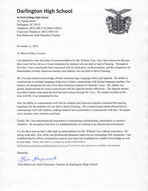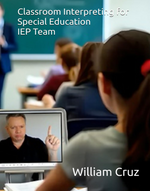









Guillermo Cruz
Guillermo Cruz

ASL O n Zoom .com

SCROLL DOWN TO VIEW CREDENTIALS
Inclusion and Autonomous Learning
"One of the most effective ways to foster inclusion in education is by promoting autonomous learning. Providing students with the tools and resources necessary to navigate their educational environment independently enhances their confidence and engagement. The importance of fostering independence in students is priceless, particularly those who rely on interpreters or assistive technology, to create a more inclusive classroom experience".
-William Cruz-
EIPA 3.8 / 2025-2030
+
ASL Classroom Interpreter
Educational Interpreter

Classroom Interpreter
Author, Cartoonist
and Technologist
Mr. William Cruz

3.8
Results Score 2025
William Cruz LLC
ASL On Zoom.com
What others have to say about William...
Available ASAP!
Servicios de interpretación en el aula para el año escolar 2022
2025-2026 School Year
EDUCATIONAL ASL
Guillermo Cruz
Intérprete remoto en el aula.
Licenciatura en Psicología.
Certificación EIPA. 3.6
Más de 20 años,
Experiencia de interpretación en el aula.
Trilingüe: ASL, español, inglés.
Papá y Dibujante.
PUBLISHED WORKS



Acerca de: Guillermo Cruz
Gallaudet University CEU Online Otoño 2021.
Curso de otoño de 2021: conocimiento/ética completado.
Curso de Otoño 2021- Conocimiento Generalista
Preparación completada.
Universidad de la Costa de California 2016.
Licenciatura en Psicología 2016:
Mis estudios incluyeron enfatizar la necesidad del pensamiento científico y crítico, los temas incluyeron un estudio de la biología y el comportamiento, el proceso sensorial, el desarrollo humano, la percepción, el aprendizaje y la motivación, la emoción, la personalidad, los trastornos psicológicos, la terapia y la interacción social también se examinan para proporcionar estudiantes con una sólida comprensión de los hechos, principios y teorías que componen el campo de la psicología.
Mi trabajo como Intérprete de Aula Educativa me ha permitido trabajar con estudiantes de todas las edades, incluyendo usando la Arteterapia como herramienta para empoderar a los estudiantes. Además, Art se convirtió en Instrumental en la creación de conciencia sobre los desafíos las familias sin hogar y sus hijos enfrentan cada día.
Soy un profesional certificado que proporciona interpretación y otros servicios de apoyo a estudiantes con discapacidad auditiva que reciben toda o parte de su educación en un salón de clases junto con niños oyentes. Mi función principal es facilitar la comunicación entre los estudiantes con discapacidad auditiva, su capacidad auditiva. compañeros, el maestro del salón de clases y otro personal en el sistema escolar.
Bienvenido a ASL en Zoom. com
Map Project provides information on the minimum state requirements for educational interpreters. These requirements were pulled directly from the regulatory documents available for each state.
What others have to say about William...
"William es excelente como intérprete.
Siempre es minucioso y agradable.
mientras apoya a los asistentes a
mi conferencia cada mes.
¡Gracias William por todo lo que haces!"
Crystal Y. Sanford, M.Ed, MA CCC-SLP
"Deaf people can do anything hearing people can do, except hear."
– Dr. I. King Jordan, the first deaf president of Gallaudet University




Dun & Bradstreet D-U-N-S® Number for WILLIAM CRUZ LLC
D-U-N-S number: 920858031/130858029










































